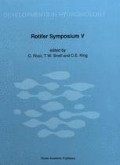Abstract
The community structure and dynamics of the rotifers of an abandoned and inundated limestone quarry are described. Zooplankton standing crop is low, but the community is rich in species. Ploesoma hudsoni and Filinia hofmanni are rare or unknown in a perimeter of several hundreds of kilometers around the lake. This illustrates that (passive?) dispersal across large stretches of land even occurs in rare species. Temporal and spatial distribution, together with specific diurnal vertical movements in different seasons facilitate the coexistence of numerous species in the lake. This complex ecology contrasts with the small size of the initial propagules that helped colonise the lake.
Access this chapter
Tax calculation will be finalised at checkout
Purchases are for personal use only
Preview
Unable to display preview. Download preview PDF.
References
Cushing, D. H., 1951. The vertical migration of planktonic Crustacea. Biol. Rev. 26: 158–192.
De Ridder, M., 1973. Atlas provisoire des Rotifères de Belgique. J. Leclercq & C. Gaspar, eds, Gembloux.
Dumont, H. J., 1977. Biotic factors in the population dynamics of rotifers. Arch. Hydrobiol. Beih. 8: 98–122.
Elliot, J. E., 1977. Seasonal changes in the abundance and distribution of planktonic rotifers in Grasmere (English Lake District). Freshwat. Biol. 7: 147–166.
George, M. G. & C. H. Fernando, 1970. Diurnal migration in three species of Rotifers in Sunfish Lake, Ontario. Limnol. Oceanogr. 15: 218–223.
Hofmann, W., 1977. The influence of abiotic environmental factors on population dynamics in planktonic rotifers. Arch. Hydrobiol. Beih. 8: 77–83.
Hutchinson, G. E., 1967. A treatise on limnology. Vol.2: Introduction to Lake biology and the Limnoplankton. Wiley, New York. 1155 pp.
Koste, W., 1980. (Über zwei Plankton-Radertiertaxa Filinia australiensis n.sp. und Filinia hofmanni n.sp., mit Bemerkungen zur Taxonomy der longiseta-terminalis-Gruppe. Genus Filinia Bory de St. Vincent, 1824, Familie Filiniidae Bartos 1959, (Überordnung Monogononta). Arch. Hydrobiol. 90: 230–256.
Lane, P. A., 1975. The dynamics of aquatic ecosystems: a comparative study of the structure and dynamics of four zooplankton communities. Ecol. Monogr. 45: 307–336.
Larsson, P., 1971. Vertical distribution of planktonic rotifers in a meromictic lake; Blankvatn near Oslo, Norway. Norway. J. Zool. 19: 47–75.
Makarewicz, J. C. & G. E. Likens, 1975. Niche analysis of a zooplankton community. Science 190: 1000–1003.
Mc Naught, D. C. & A. D. Hasler, 1964. Rate of movement of populations of Daphnia in relation to changes in light intensity. J. Fish Res. Bd Can. 21: 291–316.
Miracle, M. R., 1974. Niche structure in freshwater zooplankton: a principal components approach. Ecology 55: 1306–1317.
Miracle, M. R., 1977. Migration, patchiness, and distribution in time and space of planktonic rotifers. Arch. Hydrobiol. Beih. 8: 19–37.
Pejler, B., 1957. Taxonomical and ecological studies on planktonic Rotatoria from northern Swedish Lapland. Kgl. Svenska Vetenskapskad. Handl. 4: 1–68.
Pourriot, R., 1965. Recherches sur l’écologie des Rotifères. Vie Milieu Suppl. 21. 224 pp.
Ruttner-Kolisko, A., 1974. Plankton rotifers: Biology and Taxonomy. Binnengewasser Suppl. 26. 146 pp.
Schaber, P. & A. Schrimpf, 1984. On morphology and ecology of the Filinia-terminalis-longiseta-growp (Rotatoria) in Bavarian and Tyrolean lakes. Arch. Hydrobiol. 101: 247–257.
Starkweather, P. L., 1980. Aspects of the feeding behavior and trophic ecology of suspension-feeding rotifers. Hydrobiologia 73: 63–72.
Stemberger, R. S. & M. S. Evans, 1984. Rotifer seasonal succession and copepod predation in Lake Michigan. J. Great Lakes Res. 10: 417–428.
Stewart, L. G. & D. G. George, 1987. Environmental factors influencing the vertical migration of planktonic rotifers in a hypereutrophic tarn. Hydrobiologia 147: 203–208.
Author information
Authors and Affiliations
Editor information
Editors and Affiliations
Rights and permissions
Copyright information
© 1989 Kluwer Academic Publishers
About this paper
Cite this paper
Bogaert, G., Dumont, H.J. (1989). Community structure and coexistence of the rotifers of an artificial crater lake. In: Ricci, C., Snell, T.W., King, C.E. (eds) Rotifer Symposium V. Developments in Hydrobiology, vol 52. Springer, Dordrecht. https://doi.org/10.1007/978-94-009-0465-1_21
Download citation
DOI: https://doi.org/10.1007/978-94-009-0465-1_21
Publisher Name: Springer, Dordrecht
Print ISBN: 978-94-010-6694-5
Online ISBN: 978-94-009-0465-1
eBook Packages: Springer Book Archive

